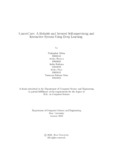| dc.contributor.advisor | Noor, Jannatun | |
| dc.contributor.author | Khisa, Pushpakali | |
| dc.contributor.author | Hossain, Arisha | |
| dc.contributor.author | Raihana, Anika | |
| dc.contributor.author | Khan, Alisha | |
| dc.contributor.author | Tonu, Tamanna Sultana | |
| dc.date.accessioned | 2024-01-03T08:04:37Z | |
| dc.date.available | 2024-01-03T08:04:37Z | |
| dc.date.copyright | 2023 | |
| dc.date.issued | 2023-01 | |
| dc.identifier.other | ID: 19101241 | |
| dc.identifier.other | ID: 19101061 | |
| dc.identifier.other | ID: 19101095 | |
| dc.identifier.other | ID: 19101411 | |
| dc.identifier.other | ID: 19101155 | |
| dc.identifier.uri | http://hdl.handle.net/10361/22059 | |
| dc.description | This thesis is submitted in partial fulfillment of the requirements for the degree of Bachelor of Science in Computer Science, 2023. | en_US |
| dc.description | Cataloged from PDF version of thesis. | |
| dc.description | Includes bibliographical references (pages 65-68). | |
| dc.description.abstract | Cancer is the ultimate global health issue in the 21st century, as its burden is in creasing day by day. In the year 2020 [36], 18.1 million cancer cases were estimated,
where 9.3 million were men and 8.8 million were women. Among these, many of
the cases are detected at a very crucial stage due to a lack of advanced technologies
to detect early symptoms, misinformation and ignorance. In recent years, the inno vation of many healthcare systems are capable of contributing to raising awareness
and providing significant assistance to both oncologists to detect cancer disease and
patients, which are progressively surging in popularity in the medical sector. How ever, [15] manual detection of cancer cells from the histopathological image is a very
tiring, time-consuming process for histopathologists and many human errors can
occur. Therefore, many computer-based detection processes have been invented,
giving better results than the manual detection process. Although several archi tectures have been introduced, it becomes a question of which architecture gives
us the best result for detecting cancer cells. In this proposed framework, we have
analyzed five deep Convolutional Neural Network architectures such as VGG16,
MobileNetV3, InceptionV3, Xception, and DenseNet121, which have been trained
and tested on the lung cancer and colon cancer datasets, present the performance
comparison between them and found out the best image recognition and classifica tion architecture which have given us the utmost accuracy for detecting any type
of cancerous histopathological cell. Moreover, we have also designed a prototype
for a user-friendly, self-supervising and reliable platform (“CancerCare” mobile ap plication) with some key features after conducting a survey in Bangladesh to make
it easier for oncologists as well as patients to deal with this fatal disease. Besides,
it also perpetuates smoother communication between patients and oncologists on
a regular basis via live chat and video consultation. At present times, misuse of
data in mHealth applications is one of the most noted risks. Therefore, we have
established authentication using firebase. | en_US |
| dc.description.statementofresponsibility | Pushpakali Khisa | |
| dc.description.statementofresponsibility | Arisha Hossain | |
| dc.description.statementofresponsibility | Anika Raihana | |
| dc.description.statementofresponsibility | Alisha Khan | |
| dc.description.statementofresponsibility | Tamanna Sultana Tonu | |
| dc.format.extent | 68 pages | |
| dc.language.iso | en | en_US |
| dc.publisher | Brac University | en_US |
| dc.rights | Brac University theses are protected by copyright. They may be viewed from this source for any purpose, but reproduction or distribution in any format is prohibited without written permission. | |
| dc.subject | Histopathological cell image | en_US |
| dc.subject | Deep convolutional neural network | en_US |
| dc.subject | VGG16 | en_US |
| dc.subject | VGG19 | en_US |
| dc.subject | ResNet50 | en_US |
| dc.subject | ResNet152 | en_US |
| dc.subject | Xception | en_US |
| dc.subject | DenseNet12 | en_US |
| dc.subject | Survey | en_US |
| dc.subject | Image recognition | en_US |
| dc.subject | Oncologists | en_US |
| dc.subject.lcsh | Cognitive learning theory (Deep learning) | |
| dc.title | CancerCare: A reliable and secured self-supervising and interactive system using deep learning | en_US |
| dc.type | Thesis | en_US |
| dc.contributor.department | Department of Computer Science and Engineering, Brac University | |
| dc.description.degree | B.Sc. in Computer Science | |

